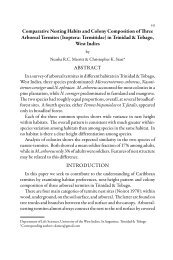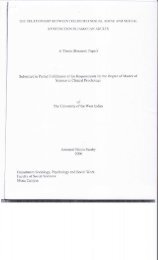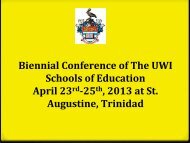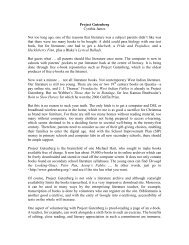Thinking Critically about Teaching Critical Thinking - Uwi.edu
Thinking Critically about Teaching Critical Thinking - Uwi.edu
Thinking Critically about Teaching Critical Thinking - Uwi.edu
You also want an ePaper? Increase the reach of your titles
YUMPU automatically turns print PDFs into web optimized ePapers that Google loves.
<strong>Thinking</strong> <strong><strong>Critical</strong>ly</strong> About <strong>Critical</strong> <strong>Thinking</strong><br />
Patricia Worrell<br />
In July 2004, I attended a workshop in North Carolina on “<strong>Teaching</strong> <strong>Thinking</strong> Skills.” In<br />
many ways it was an exciting experience. I was able to hear <strong>edu</strong>cators from the United<br />
States, England, and Asia describe their own experiences as they sought to help their<br />
students develop as critical thinkers. In addition, I was privileged to listen to a number of<br />
leaders in the field, including Bob Ennis, David Perkins, and the chief facilitators of the<br />
workshop, Robert Swartz and Art Costa, talk <strong>about</strong> their areas of expertise—the nature of<br />
critical thinking, the most effective strategies for helping students develop as critical<br />
thinkers, and the most effective techniques for assessing critical thinking.<br />
I emerged with two strong convictions. One was that this area holds considerable promise<br />
for <strong>edu</strong>cation here in the Caribbean. Teachers and curriculum officers at the workshop<br />
spoke repeatedly <strong>about</strong> how greatly students benefited from thinking skills instruction.<br />
Not only were their students able to select appropriately from among the strategies they<br />
had been taught, but also in applying thinking skills, they often showed that they had<br />
acquired a surer grasp of concepts from the fields of study in which their thinking skills<br />
instruction had been infused. Moreover, students often developed what Costa terms the<br />
dispositions, or habits of mind, that support sound thinking and enable students to take<br />
charge of their own learning—they became “self managing, self monitoring and self<br />
modifying.”<br />
I was pleased, therefore, to recall that in addition to the work already being done by<br />
individual teachers and teacher <strong>edu</strong>cators to promote instruction in thinking skills, and<br />
especially in skills of critical thinking, many of our own curriculum documents and<br />
examination syllabuses here in the Caribbean have begun to reflect a concern that critical<br />
thinking should be taught and assessed within the curriculum.<br />
My second conviction was that our adoption of critical thinking instruction must be<br />
accompanied by more careful reflection and inquiry as to why and how we propose to<br />
include it in our curricula. If it is to take root in the curriculum, we must understand not<br />
only the promise it holds, but also its limitations, given what we now know of the field.<br />
We must also identify what our own cultural practices have to offer as we plan<br />
instruction that students will perceive as relevant and transferable to their lives outside<br />
the school compounds.<br />
We must acknowledge, first, that many basic issues still remain to be addressed by<br />
researchers and practitioners. The very question of what constitutes effective critical<br />
thinking is still open to discussion. For instance, David Perkins has suggested that critical<br />
thinking requires a discrete set of cognitive skills from creative thinking, while others in<br />
the field seem to suggest that both types of thinking can be developed in the same way,<br />
and through similar processes.<br />
In addition, there is still much to be learned <strong>about</strong> the dispositions and strategies that<br />
critical thinkers habitually exhibit. One prime example is the role of metacognition in the<br />
1
process. It is generally agreed that metacognitive strategies—for monitoring our thinking<br />
and planning processes—are essential for effective critical thinking. Yet even the nature<br />
of metacognition itself is still open to debate. Consequently, as one researcher has noted,<br />
many practitioners make claims <strong>about</strong> students’ use of metacognitive strategies when<br />
little evidence sometimes exists to suggest that such strategies are, in fact, being used.<br />
Educators at the workshop in North Carolina repeatedly expressed concern that while<br />
they had introduced instruction in critical thinking at all levels of the curriculum, they<br />
were not always sure that they were really helping their students to develop and use<br />
metacognitive strategies, especially when those students were unable to articulate how<br />
they were thinking. Teachers of younger students, in particular, voiced this concern.<br />
What was interesting was that the facilitators of the workshop, and presenters like Bob<br />
Ennis who has made a career of developing techniques for assessing critical thinking,<br />
also seemed unsure as to how this issue might be addressed. Ennis admitted that the<br />
techniques he has developed cater heavily to students with high levels of linguistic<br />
intelligence, and less so to students who are stronger in other intelligences. One of the<br />
facilitators of the workshop, Bob Swartz, argued that as far as he was concerned, if a<br />
student couldn’t articulate the strategies he or she had used, he would not consider that<br />
the student had developed the ability to use metacognitive strategies at all. Many teachers<br />
attending the workshop agreed that their students seemed to be capable of critical<br />
thinking, including using metacognitive strategies, even from a very early age. However,<br />
if these students could not articulate their thought processes verbally, teachers had no<br />
means of knowing whether or not these students were actually using such strategies. It is<br />
an area that clearly needs to be researched further, especially if we propose to assess<br />
students’ mastery of critical thinking skills.<br />
In deciding to adopt critical thinking instruction, we in the Caribbean must also consider<br />
how we might use our students’ existing cultural capital to scaffold the process by which<br />
they develop skills and strategies in critical thinking. Josiane Hudicourt-Barnes has<br />
described, for instance, the Haitian discourse practice of bas odyans and, in particular,<br />
one form called diskysyon or argument, in which one speaker takes on the role of<br />
theoretician and makes a statement that she is expected to defend, using evidence or<br />
logic. In the meantime, a challenger also uses evidence or logic to dispute the arguments<br />
presented. Hudicourt-Barnes describes the practice as a form of theatre, in which the<br />
proponent of the idea “has the burden of remaining calm…the challenger’s role is often<br />
more theatrical, and is directed both towards the theoretician and the audience.”<br />
Ian Robertson, Dean of UWI’s Faculty of Humanities and Education, has suggested that<br />
West Indian proverbs and riddles also often reflect a critically analytical approach to the<br />
problems we face in our personal lives and in our social relationships, and may be used to<br />
support critical thinking instruction.<br />
These practices constitute potentially powerful tools to ensure that our students maintain<br />
the ability to think critically outside the classroom, and this, after all, must be the most<br />
desired outcome of any decision to adopt formal instruction in critical thinking. Even as<br />
we embrace critical thinking instruction, however, we must make provision for research<br />
2
to address the issues that still present challenges to persons interested in the field. We<br />
must, in short, temper our enthusiasm with a wholesome dose of critical thought <strong>about</strong> it.<br />
School of Education, UWI, St. Augustine<br />
3










